Key takeaways:
- Art enhances engagement and creativity in workshops, bridging gaps in understanding and fostering collaboration.
- Incorporating storytelling and visual aids in tech discussions can lead to innovative insights and dynamic problem-solving.
- Creating a dedicated art space and integrating art challenges fosters teamwork, communication, and deeper connections among participants.
- Reflection after art activities promotes introspection and enhances understanding in workshop discussions.
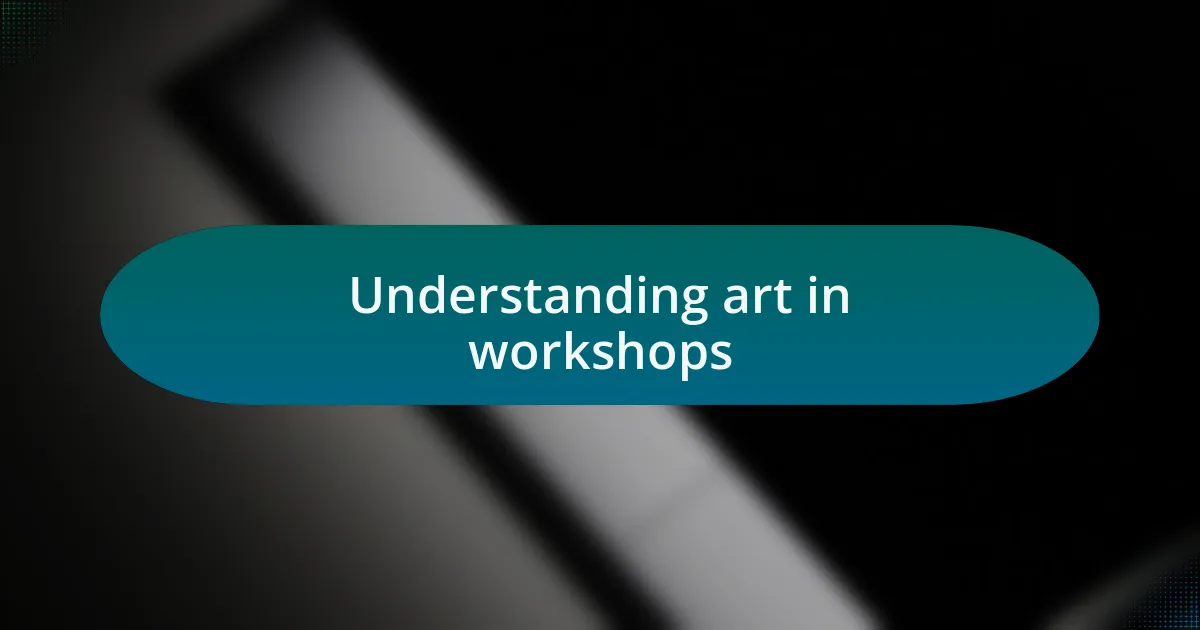
Understanding art in workshops
Art in workshops serves as a powerful tool for engagement. I remember a session where we used visual art to illustrate complex tech concepts, leading to a breakthrough moment for participants. It made me realize how creativity can bridge gaps in understanding—have you ever noticed how a simple sketch can spark a deeper discussion?
When integrating art, I often reflect on its ability to stimulate different parts of the brain. For example, during a brainstorming workshop, I encouraged everyone to create mind maps using colors and images. The energy in the room shifted; suddenly, ideas flowed freely, and collaboration felt more dynamic. Isn’t it fascinating how art can enhance our problem-solving abilities?
Moreover, I’ve seen firsthand how art encourages self-expression among participants. In sessions where I introduced journaling and drawing, attendees not only shared their technical insights but also opened up about their experiences and emotions. It made the workshops feel more human, fostering a sense of community. Isn’t that what we seek in our professional interactions?
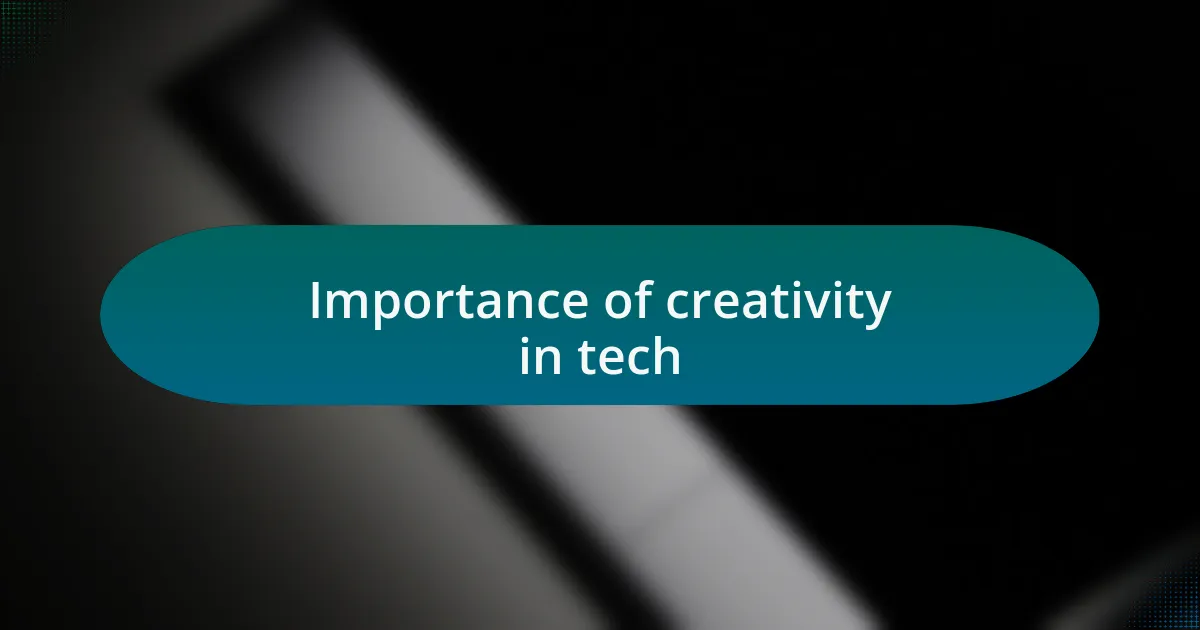
Importance of creativity in tech
Creativity in tech is vital for innovation. I often find that when team members approach a problem with an open mind, the solutions they uncover are not only more effective but also more imaginative. Have you ever experienced that ‘aha’ moment when a creative idea emerged in a group setting? It’s exhilarating to witness how fresh perspectives can redefine challenges.
I vividly recall a tech project where we incorporated storytelling into our planning sessions. By asking everyone to share their ideas through narratives, we discovered unique angles and insights. This approach not only made our discussions more engaging but also unleashed a wealth of creativity that we hadn’t tapped into before. It’s amazing how a narrative can breathe life into technical discussions, making them more relatable and inspiring.
Additionally, embracing creativity fosters resilience. I remember when my team faced unexpected setbacks during a product launch. Instead of getting bogged down, we held an impromptu brainstorming session where participants sketched out unconventional strategies. What started as a daunting challenge became an opportunity for creative problem-solving. Isn’t it incredible how a shift in perspective can turn obstacles into gateways for innovation?
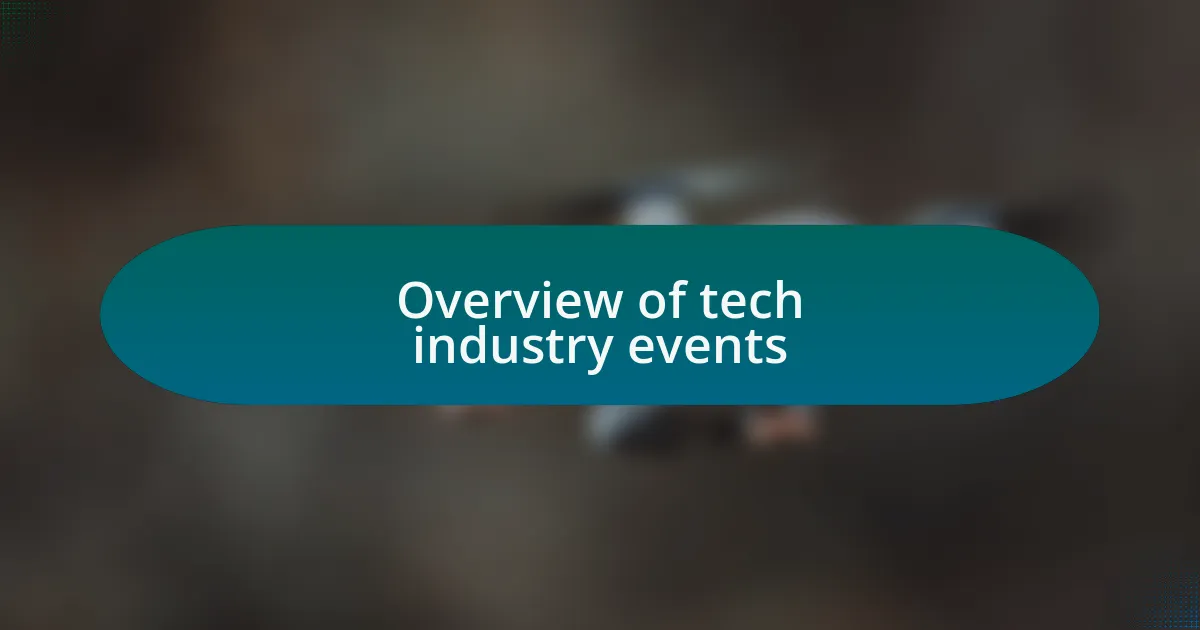
Overview of tech industry events
Tech industry events play a crucial role in bridging the gap between innovation and practice. I’ve participated in various conferences and workshops, and I’ve always been struck by how they serve as a melting pot for ideas and ingenuity. These events facilitate networking, where I frequently encounter professionals eager to share their latest advancements and strategies.
At one particular industry event, I recall attending a hands-on session focused on emerging technologies. The energy in the room was palpable as participants collectively tackled real-world challenges using new tools. This collaborative spirit not only enhanced my understanding but also reinvigorated my passion for tech. Have you ever left a workshop feeling inspired and ready to implement fresh ideas? It’s those moments that remind me of the invaluable impact of these gatherings.
Moreover, these events often showcase not just the latest trends, but also highlight essential soft skills like communication and creativity. In a recent panel discussion, a speaker emphasized the importance of art in tech, drawing parallels that resonated deeply with me. It made me reflect on how often we overlook the creative aspects in our technical world. Isn’t it fascinating to consider how a blend of creativity and technology can shape our future?
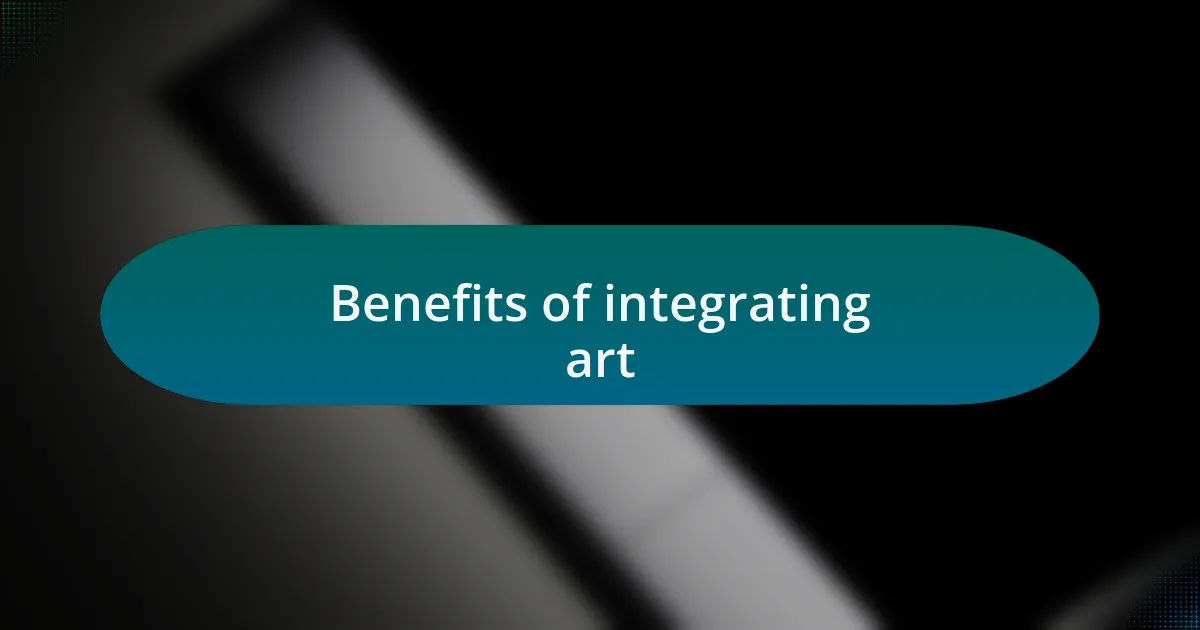
Benefits of integrating art
Integrating art into workshops can significantly enhance creativity and innovation. I remember a workshop where participants created visual art to express complex tech concepts. The shift in perspective was dynamic; suddenly, ideas flowed more freely, bridging gaps I never knew existed. Isn’t it remarkable how visual expression can simplify what seems intricate?
Another benefit is the emotional resonance it creates among participants. I vividly recall an art-focused team-building exercise that transformed a group of skeptics into collaborators. Watching as my colleagues connected over a simple painting activity was an eye-opener. It illustrated that shared experiences in creative expression foster trust and camaraderie, enriching the overall workshop experience.
Lastly, art encourages diverse thinking. By integrating artistic elements, I’ve witnessed participants step outside their comfort zones, explore unconventional solutions, and challenge standard protocols. When was the last time you tried something completely different in your work? This willingness to experiment not only invigorates the group but also cultivates a culture of innovation that is vital in the tech industry.
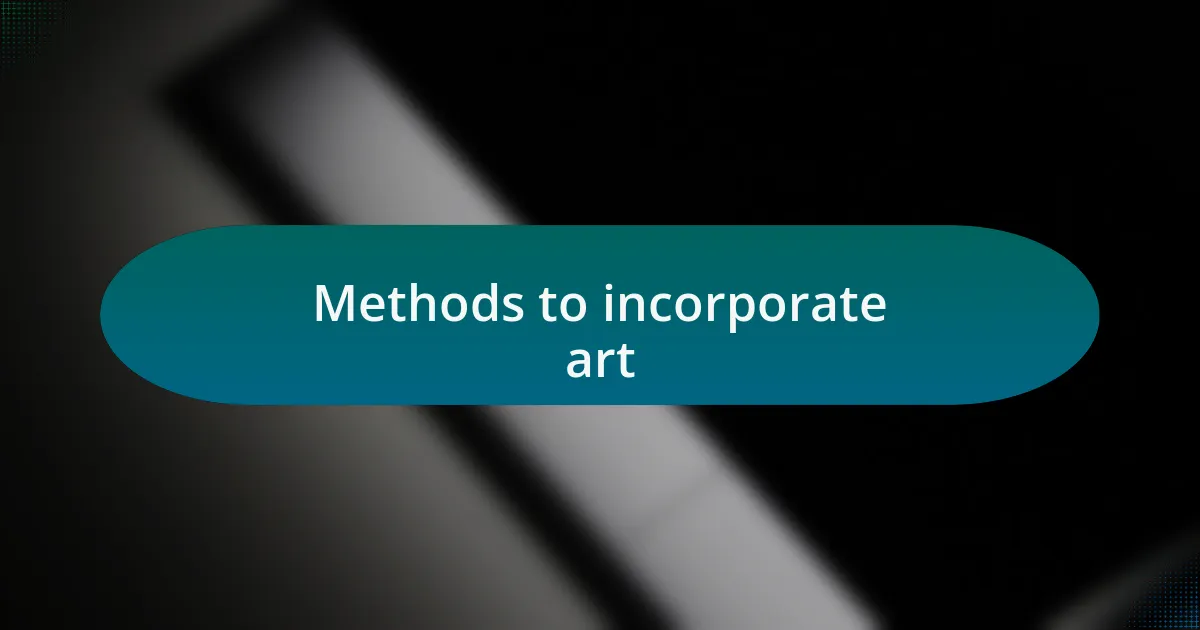
Methods to incorporate art
Incorporating art into workshops can take various forms, but I’ve found that using collaborative mural projects works wonders. During one particularly memorable session, we transformed a blank wall into a vibrant representation of our collective goals. Participants brought their unique styles and ideas to the table, resulting in a piece that not only beautified the space but also symbolized our shared aspirations. Have you ever experienced the magic of creating something as a group? It’s truly transformative.
Another method involves using storytelling through visual aids. I often encourage participants to create storyboards or comic strips that capture their concepts. Just last month, I facilitated a session where one team illustrated their product journey through a comic. The humor and creativity flowed, making an otherwise technical presentation engaging and memorable. Isn’t it fascinating how visuals can breathe life into the most complex topics?
Lastly, incorporating performance art, such as improvisational theater, adds an unexpected twist to traditional workshops. I recall a particularly lively session where participants acted out scenarios related to problem-solving in tech. The laughter and spontaneity not only eased tension but also led to genuine insights about communication and teamwork. What if you could express your professional challenges through performance? It’s an approach that leaves a lasting impression and deepens understanding.
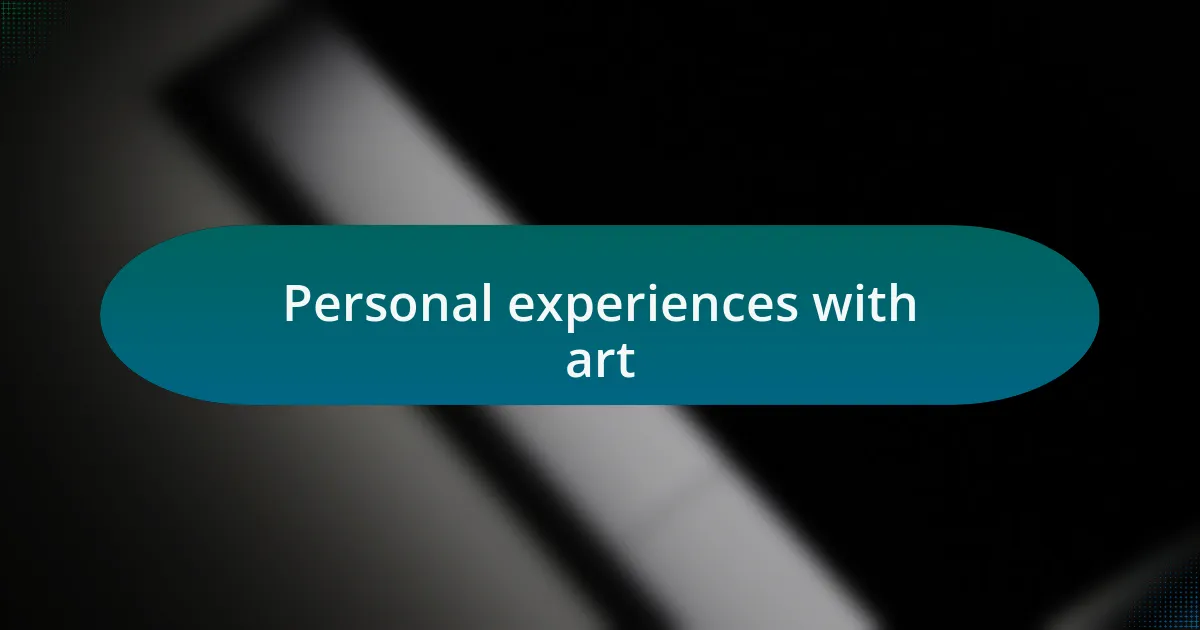
Personal experiences with art
Art has always held a special place in my heart, serving as a creative outlet that complements my professional life. I remember a time when I took a pottery class during a particularly stressful workweek. As my hands molded the damp clay, I felt an overwhelming sense of peace wash over me—it’s amazing how engaging with art can clear the mind. Have you ever found solace in a creative endeavor? It’s like therapy, but with a tangible outcome.
One unforgettable experience was when I attended a local art gallery opening. The vibrant colors and innovative pieces sparked so many conversations among attendees, creating connections I hadn’t anticipated. I left that night not just inspired by the art, but also motivated to incorporate those spontaneous discussions into my own workshops. Isn’t it incredible how art can bridge gaps between strangers and foster community?
Moreover, I’ve dabbled in digital art, which has allowed me to merge my tech background with creativity. I recall creating a series of abstract designs that echoed themes of innovation and collaboration, each piece telling its own story. This creative process revealed new angles on problem-solving that I could share with workshop participants. How often do we harness the power of our artistic side to unlock new perspectives? It’s a game-changer, and I believe it can elevate our professional exchanges.
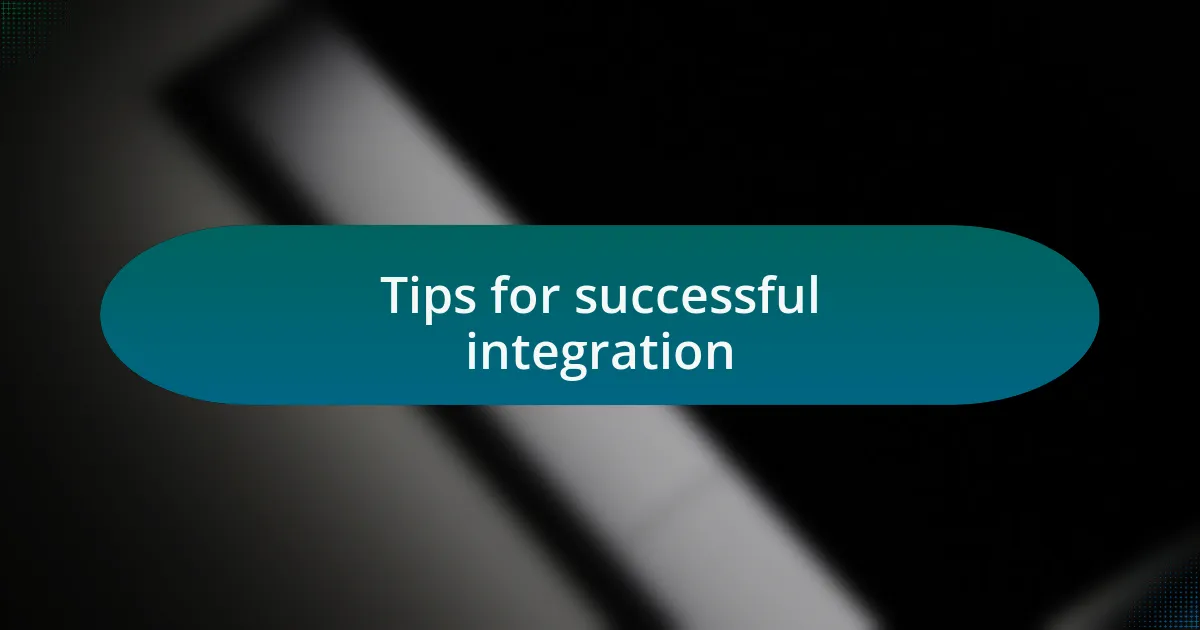
Tips for successful integration
In my experience, creating a dedicated space for art within workshops can significantly enhance engagement. I once transformed a corner of my usual meeting room into an art station—simple materials, like colored markers and paper, were all I needed. The change in atmosphere was palpable, with participants drawing inspiration from one another as they collaborated and shared ideas—the visual creativity flowed, and I could feel the energy shift. Have you ever witnessed how an inviting environment can alter the dynamics of a meeting?
Another effective tip is to incorporate art challenges that relate directly to the themes of your workshop. I remember hosting a session focused on teamwork where I asked participants to collaboratively design a mural that symbolized their collective goals. The laughter and shared frustrations during the process broke down barriers, leading to deeper connections. Isn’t it fascinating to see how art can act as a catalyst for teamwork and communication?
Finally, don’t underestimate the power of reflection after art integration activities. After a creative exercise, I always encourage a moment of silence for participants to jot down their thoughts or feelings. This practice not only promotes introspection but also enables them to articulate insights that can be beneficial for our discussions. Have you seen how reflective practices can deepen understanding and retention? It’s a simple yet impactful step that we often overlook in the hustle of a workshop.